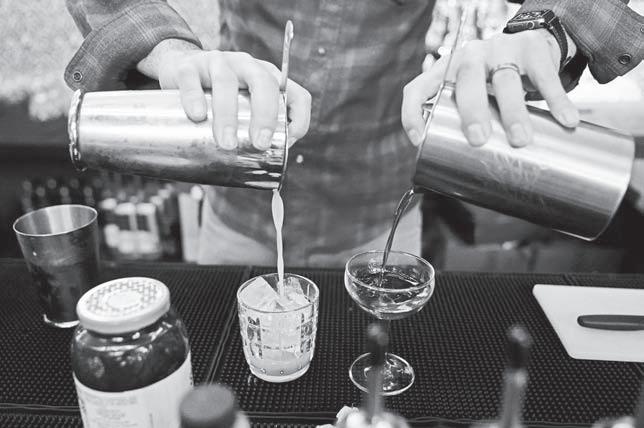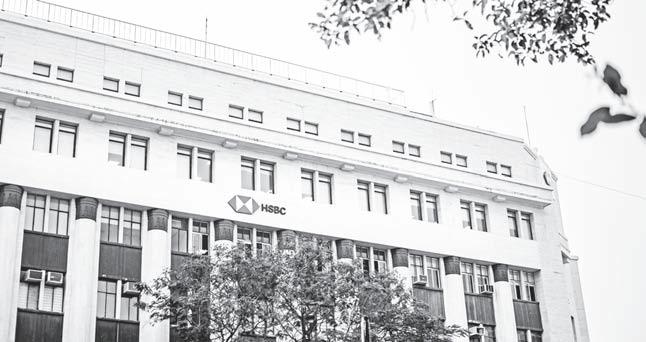
11 minute read
Whiskey vs beer: Spirits beat brews in new US market data
By Bruce Schreiner & Jim Salter
The Associated Press
LOUISVILLE, Ky.—Producers of spirits have new bragging rights in the age-old whiskey vs. beer barroom debate.
New figures show that spirits surpassed beer for US market-share supremacy, based on supplier revenues, a spirit industry group announced Thursday.
The rise to the top for spirit-makers was fueled in part by the resurgent cocktail culture—including the growing popularity of ready-to-drink concoctions—as well as strong growth in the tequila and American whiskey segments, the Distilled Spirits Council of the United States said.
In 2022, spirits gained market share for the 13th straight year in the fiercely competitive US beverage alcohol market, as its supplier sales reached 42.1 percent, the council said.
After years of steady growth, it marked the first time that spirit supplier revenues have surpassed beer—but just barely, the spirit industry group said. Beer holds a 41.9 percent market share, it said.
“Despite the tough economy, consumers continued to enjoy premium spirits and fine cocktails in 2022,” Distilled Spirits Council President and CEO Chris Swonger said. Overall spirit supplier sales in the US were up 5.1 percent in 2022 to a record $37.6 billion, the group said. Volumes rose 4.8 percent to 305 million 9-liter cases.
Seemingly unfazed, Brian Crawford, president and CEO of the Beer Institute, insisted that beer “remains America’s number one choice in beverage alcohol.”
“It’s interesting to hear liquor companies boast about making money hand-over-fist while simultaneously going state-to-state hunting for more tax carveouts from state legislatures,” Crawford said in a statement.
Benj Steinman, president of Beer Marketer’s Insights, a leading beer industry trade publication, said the beer industry saw unprecedented growth in the 1970s, growing at a pace of 4 percent annually. As recently as 2000, beer’s share in the alcohol market was 58 percent.
Over the past several decades, beer’s growth has essentially been flat. Meanwhile, spirits have flourished, especially over the past two decades.
“I think there’s just a long arc on these things,” Steinman said.
Steinman and Bart Watson, chief economist at the Brewers Association, a craft beer industry trade group, agreed there are several reasons for the shift to spirits.
“Some of it’s just the younger generation coming up, looking for a lot of variety,”Steinman said. “They sometimes like spirits. Cocktail culture is another thing.”
Watson cited data showing that liquor has become 20 percent cheaper relative to beer in recent decades.
“Price is a particularly large part of the story,” he said.
Another factor is advertising and marketing. Watson pointed to the success of spirits in its outreach to women. Steinman said distilled spirits now advertise freely, something they didn’t do generations ago.
“They’ve increased their availability. They’ve increased their ability to advertise. They’ve had a lot of legislative and policy wins that have enabled growth for distilled spirits,” Steinman said.
For spirit producers, reaching the market share milestone was worth toasting.
At Baltimore Spirits Company in Maryland, the head distiller and the manager of its cocktail bar said they are pleased with the rise in the consumption of spirits.
Eli Breitburg-Smith, head distiller and cofounder, said the distillery founders saw a space in the market to make rye whiskey as consumer demand was growing.
“We did see that it was going to be on the rise,” he said. “Now, I don’t know that we thought it would be overtaking beer or anything like that, but we felt like there was a good space in the market for new whiskey, original whiskey, and people that...were making a unique product.”
Gregory Mergner, the general manager of the distillery’s cocktail gallery, said he didn’t anticipate spirits rivaling or surpassing beer for market share.
“As ubiquitous as beer is. don’t think anybody could have foreseen whiskey overtaking it,” he said.
The spirit sector’s rise has coincided with a growing thirst for high-end, super-premium products.
That trend toward premiumization slowed overall in 2022. But it remained strong because of growth in the tequila/mezcal and American whiskey categories, the Distilled Spirits Council said.
More than 60 percent of the spirit sector’s total US revenue last year came from sales of high-end and super-premium spirits, mostly led by tequila and American whiskey, said Christine LoCascio, the group’s chief of public policy and strategy. Those high-end products fetch the highest prices.
“While many consumers are feeling the pinch from inflation and reduced disposable income, they are still willing to purchase that special bottle of spirits choosing to sip a little luxury and drink better, not more,”LoCascio said.
Within the spirit sector, vodka maintained its status as the top revenue producer at $7.2 billion, though sales were flat in 2022, the group said.
In the tequila/mezcal category, sales rose 17.2 percent, or $886 million, totaling $6 billion, it said.
Sales for American whiskey were up 10.5 percent, or $483 million, to reach $5.1 billion, it said. The American whiskey category includes bourbon, Tennessee whiskey and rye whiskey.
Brandy and cognac sales were down 12.3 percent, with revenues totaling $3.1 billion.
Premixed cocktails were the clear leader as the fastest-growing spirit category.
Sales for premixed cocktails, including ready-to-drink spirit products, surged by 35.8 percent, or $588 million, to reach $2.2 billion, the council said.
Meanwhile, spirit sales volumes in restaurants and bars—referred to as onpremise sales—continued to recover from pandemic-era shutdowns but they remained 5 percent lower than 2019 levels, the council said. Those sales represent about 20 percent of the US market.
Off-premise sales volumes at liquor stores and other retail outlets remained steady in 2021 and 2022, after experiencing sharp gains during the pandemic restrictions in 2020, it said.
Meanwhile, there is a crossover strategy brewing in the alcohol market.
Steinman said that even the big players in the beer industry “are playing in all these different growth arenas, including spirits.”
Molson Coors changed its name in 2019, going from Molson Coors Brewing Co. to Molson Coors Beverage Co. Watson noted that the No. 2 canned ready-to-drink liquor product, Cutwater, is made by AnheuserBusch InBev.
For beer producers, the reversal in marketshare rankings is no reason to cry in their suds. Watson cautioned that the market share trend could flip, calling it “likely at some point we’ll see beer grow again at the expense of other segments.” national with global dreams,” blared the HSBC Holdings Plc ad outside an upscale Mumbai suburb in December. The 122foot billboard displayed a tiger stalking over the British bank’s hexagonal red logo—a not-too-subtle signal of its ambitions to dominate the financial industry of what’s by some estimates now the world’s most populous country.
Those expansion plans are vital to shore up growth at Europe’s largest lender, which is grappling with a downturn in profits from the Greater China region. Shanghai and Hong Kong have been the bank’s centers of gravity since opening its doors more than 150 years ago to fund trade between Europe and Asia. But as a slowing economy and crackdowns on industries from technology to real estate roil the world’s second-largest economy, HSBC is looking further afield to India— despite risks there as well.
The bank is planting its sights more firmly on the ultra-rich in India, where the wealth held by billionaires has crossed $400 billion from $148 billion in 2016. It also plans to launch an onshore private banking service in the South Asian country this year. After buying an investment business with $10.8 billion in assets under management there, it’s scouring for other selective purchases. “We certainly are always looking for bolt ons that would help us drive our capabilities further,” Surendra Rosha, co-head of Asia-Pacific at HSBC said in an interview in mid-January.
Expanding in the South Asian country can come with a string of uncertainties. In recent weeks, a short-seller report on the conglomerate of billionaire Gautam Adani has roiled his empire, caused a slump of more than $100 billion in his shares, and raised concerns about the extra collateral he needed for loans. While Adani has sought to calm investors by repaying loans and pledging to reduce debt ratios, the crisis has highlighted the pressures banks can face when doing business in India. “HSBC has been in India for over 160 years, and takes a very long term view of the country and its potential. There have been many upheavals over these years, and just as past episodes didn’t alter HSBC’s stance and commitment, nor will the current market noise,” Hitendra Dave, who runs HSBC India, said via e-mail this week. HSBC declined to comment on Adani. The lender—which is focused on green energy transition—didn’t have a banking relationship with the entrepreneur given his ongoing exposure to the coal industry, people familiar with the matter said. The Adani Group didn’t respond to a request for comment.
Steady streams of senior HSBC executives have flown in to India over the past year. Chairman Mark Tucker met the head of India’s G-20 preparation committee in December. Chief Executive Officer
Noel Quinn was pictured signing a book of condolence for the late Queen Elizabeth II at the UK embassy, when he was in the country in September to meet clients. The bank has seen an uptick among worldwide customers’ pushing into India, and the high-profile visits signal its growing interest in the country, Rosha said.
“It is a conscious effort,” he said. “And I certainly think that you will see more of that in the coming years.”
Quinn’s visit to India saw him call on several of India’s wealthiest businessmen, including Mukesh Ambani and Uday Kotak, according to a person familiar with the visit. Representatives for Ambani declined to comment, and spokespeople for Kotak didn’t respond to a request for comment.
HSBC’s bet on India—and the hurdles it must surmount to get the investments to pay off—shows the complicated decisions multinationals are being forced to make as the Chinese economic juggernaut slows. Last year, violent protests against virus lockdowns at a Foxconn factory served up a sharp reminder to international businesses like Apple Inc. of the dangers of over reliance on individual markets.
In 2021, HSBC got about 44 percent of its total $21.9 billion in adjusted profits from Hong Kong and China while Hong Kong and mainland customers made up more than a third of its total. But China’s problems have struck at the core of the HSBC profit machine in Hong Kong where 2022 half-year profits were down around 30 percent year-on-year.
Meanwhile, the International Monetary Fund projects India’s gross domestic product grew 6.8 percent in 2022, putting it among the world’s fastest growing major economies. “Once people become that wealthy in a domestic economy they start investing abroad,” said Dave.
The lender is now the largest foreign financial institution operating in India. In 2021, India-based employee numbers overtook those in the UK to become the bank’s largest center by headcount. HSBC’s investment bankers made more in India that year than in China, and commercial banking profits are not far behind those of the lender’s mainland Chinese unit. In January, chairman Tucker, speaking at the Asian Financial Forum conference, said Asia’s growth was “not just a story about Hong
Kong and mainland China.”
India was a hugely attractive market, he said. “This could be a basis for a 20 to 30-year runway for growth, as was the case for China in the 1990s.”
Despite such optimism, analysts say India is riddled with its own structural problems that have the potential to limit the economy over time. Rapid growth can also mean bigger risk as executives and businesses rush to expand.

In recent weeks, a New Yorkbased short seller Hindenburg Research published a detailed report on the Adani empire—alleging the group used a web of firms in tax havens to inflate revenue and stock prices. Adani has denied the allegations, and his group published a 413-page rebuttal. Stocks in the Adani empire gained some days this week as its founders pre-paid some debt. HSBC wasn’t listed as an Adani financial backer in recent documents released by the group.
However, the episode demonstrates some of the myriad comp lexities of doing more business in India. “It’s a hard market to crack, and I have my doubts the economy could grow much faster than now to compensate for China,” said Tom Kirchmaier, professor at the Centre of Economic Performance at the London School of Economics.
Also, despite signs of India’s growing importance, the money it makes there pales compared to what HSBC draws in Hong Kong. Four years ago, HSBC India reached a major milestone as pretax profits broke through $1 billion for the first time in more than a century on the subcontinent. Even so, that’s just 7.5 percent of the global total.

That leaves HSBC executives with a tough balancing act politically. Recent years have been a rollercoaster ride for HSBC and its relations with China. HSBC was criticized by Chinese media outlets for providing information to US authorities in the legal case involving Huawei Technologies’ chief financial officer, forcing the bank to publicly deny that it had “framed” the telecom giant.
HSBC also faced criticism in the West over its stance on Hong Kong’s national security law, after the bank ended up publicly backing the legislation.
India and China, which fought a war in 1962, could fight another one, said Isaac Stone Fish, founder of Strategy Risks, which specializes in corporate relationships with China. “If that happens, banks like HSBC will not want to be caught in the proverbial crossfire.”
“The tensions between India and China over trade, Pakistan, and border disputes requires careful handling for banks that want to maintain large presences or investments in both countries,” he said.
HSBC also needs to appease its biggest shareholder—China’s Ping An Insurance Group Co., which has been pressuring the lender to consider proposals including spinning off its Asian operations. Ping An declined to comment on HSBC’s expansion outside of China.
The long-standing legacy of Greater China and particularly Hong Kong will be hard to shakeoff, said Angela Gallo, senior lecturer in finance at Cass Business School in London. Yet it’s “a good time to reduce this idea of their main influence coming from China,” she said. “India looks more promising in many aspects and the country is definitely on a trajectory that looks better than China.”
HSBC has begun shrinking or exiting non-core operations in other territories, including its Canadian retail network. It’s expanding in places like Singapore where many of China’s super rich are parking their money. It agreed in 2021 to buy AXA Singapore, an insurance business, for $575 million. But the size of the city state pales compared with India’s more than 1.4 billion people.
“We certainly have the support to now look at where we could add on and build capabilities,” said Dave. “That would help us to drive through our wealth penetration, our international trade and foreign exchange and other such product lines.”
HSBC already facilitates around 8 percent of India’s exports, 10 percent of foreign direct investment and 10 percent of local currency trading. Back in 1987 HSBC even installed India’s first ATM.
It still faces international competitors like Standard Chartered Plc there. Also, established major banks like Kotak Mahindra Bank, and public sector institutions like State Bank of India still have an effective lock on much of India’s domestic banking business.
“From an overall share of the market, global banks are middle of the pack in India, with leadership positions in a few areas,” said Saurabh Trehan, partner in Bain & Company’s financial services practice.
Dave said he was confident HSBC could still get ahead in the South Asian country, partly because of its global heft. There are customers in India who want to send their kids abroad, and businesses that want to make acquisitions overseas.
“There is a certain segment of the market that we can serve better than the local banks,” he said. With assistance from Preeti Singh/Bloomberg









